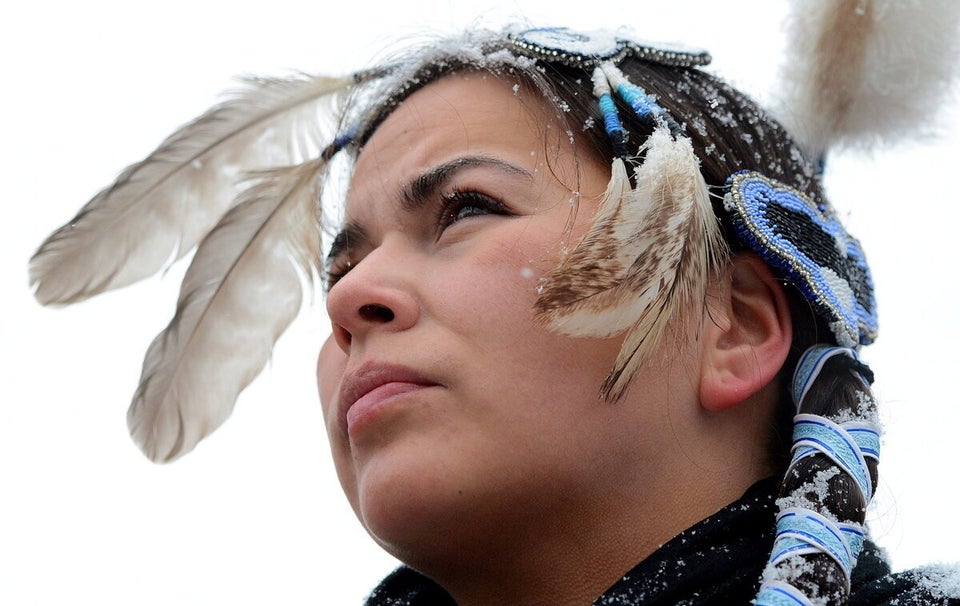Tim Knight writes the regular media column, Watching the Watchdog, for HuffPost Canada.
It's not much of a protest.
Perhaps 400 people drum, wave flags, chant, block traffic on this bitterly cold day on Yonge Street at Dundas Square.
Buckskin jackets, a few jingle dresses, a banner reading "We Are All Treaty People." And two cops standing, watching, not even anoraked against the cold. (Rumour has it that the riot squad is in buses parked in a nearby street, waiting to be called in if necessary.)
It's another Idle No More protest in Toronto -- traditional territory of the Mississaugas of the New Credit First Nation -- this one on the very first day of 2013.
It could be any one of thousands of routinely ignored First Nations protests over the past hundred years against government neglect and consequent third-world conditions.
Except it isn't.
Yes, the crowd isn't big. But there's a new energy here this day. A new focus. Along with a problem for Idle No More.
Everyone here knows that the women who started the movement on that small Saskatchewan reserve 3,000 kilometres to the west of here have had to slap down Canada's chiefs -- mostly male -- who tried to take over leadership once it hit the headlines.
Last Monday the founding women issued this statement: "The Chiefs have called for action and anyone who chooses can join with them, however this is not part of the Idle No More movement as the vision of this grassroots movement does not coincide with the visions of the Leadership."
This is a blunt reference to the fact that the nation's indigenous chiefs have largely failed to improve First Nations living standards over the years.
Some are regarded as government stooges, others as corrupt, many as simply weak.
--------------------
On this first day of 2013, some 350 kilometres to the north-east of Toronto on Victoria Island in the Ottawa River -- traditional Algonquin territory -- Attawapiskat Chief Theresa Spence starts the fourth week of her hunger strike.
She calls for peace between the Idle No More movement and the chiefs. "Let us come together in unity, because all of us, chiefs and grassroots, are one. If we are going to point fingers, let us point them squarely at this colonial government. The chiefs have made mistakes in the past, but don't shame them for these. They are, after all, our people. The chiefs are ready now to humble themselves for the people."
Canada's chiefs aren't used to being humbled. Particularly by a women.
Could it be that women are finally, in desperation, taking over leadership of the First Nations world?
After all, many tribes and bands are matrilineal (descent traced through the mother and maternal ancestors.)
--------------------
Back in Toronto, the protesters -- perhaps half indigenous, half settler -- gather in a circle under the banner "Indigenous Rights Are Non-Negotiable ... Protecting the Rights of the People who are protecting the Rights of the Planet."
A young woman takes the loudspeaker to attack successive Canadian governments for treating indigenous people like inferior dependents. "It's a new year and we want a new relationship" she shouts "nation to nation."
The crowd echoes back: "It's a new year and we want a new relationship -- nation to nation."
Tantoo Cardinal (Order of Canada, Dances With Wolves) picks up the same thread to a CityTV camera: "Canadian people really have to understand that there are two signers in the treaties. They call a certain indigenous people treaty people, right? [But] we're all treaty people. Because those agreements were signed for all nations."
--------------------
Time for the traditional round dance, a ceremony to remember and honour ancestors. Now, today, part of a protest against a distant, uncaring government.
The drums and singers start. Protesters form two huge circles in the middle of Dundas Square. On one side, a woman in buckskin and beads takes my hand. On the other side, a white teenage boy. We smile at each other.
And dance.
I've danced at powwows before, but at first, I feel awkward, silly. Old white man, descendent of British colonialists responsible for so much of this mess, daring to dance with wolves.
But as the drums, the heartbeat of Mother Earth, beat out their rhythm and the singers' voices rise and fall and we slowly circle the square, holding hands, feet sliding on the packed snow, something strong and bright and shiny happens.
We become as one. All of us -- First Nations, protesters, sympathizers, settlers, young, old, women, men, all of us holding hands and dancing this dance while the voices ring clear and the drums beat time.
And for these moments at least there is no difference among us. Only oneness, only the dance and the cause and Mother Earth and Turtle Island.
The protest ends. The banners and flags are furled. The drums are wrapped. The people drift away, most toward the subway. The two cops climb into a SUV with bicycles strapped to its back and drive off.
And I walk across the deserted white and frozen square and pass a music shop where Bob Marley sings "Get Up, Stand Up."
And it's the first day of a new year.
And perhaps a new start for Canada's First Nations.
